Vague thoughts about Buddhism, reports of the country’s beauty and outright admiration for a nation that had survived a thousand years of Chinese domination, a century of French colonialism and eleven years of American military technology all played into my decision to go to Viet Nam. Maybe there was also a need to confront some lingering shades of poorly defined patriotic guilt. Despite my poorly displayed opposition to what there is called the American War, I went to Viet Nam still expecting to be seen and, in some sneaky, snide way, treated as the enemy. But look at this guy! Look at the look he gave me when I, unmistakably American, asked, as best I could, if I could photograph him at his post in Hanoi at the Ho Chi Minh Masoleum.
“Yes! Of course! You betcha.”
And this warmth was absolutely typical of the response our group got everywhere we traveled in that country, from Hanoi in the north,
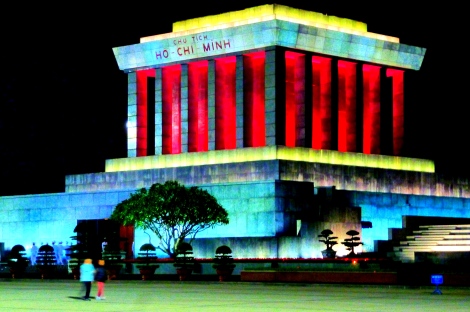
along the coast through unspeakably beautiful Ha Long Bay,
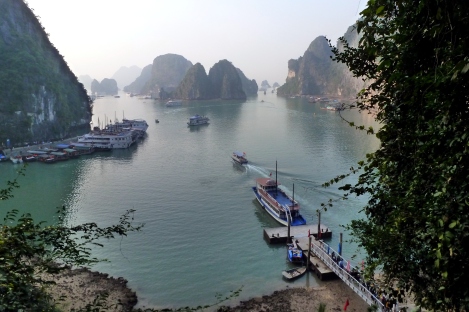
to historic Hue,

and Hoi An,
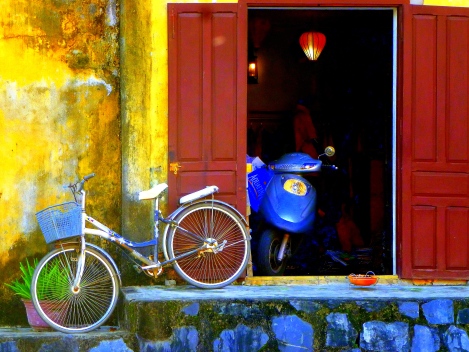
and Nha Trang,

to Da Lat,

and Ho Chi Minh City as it prepared for Tet, the new year
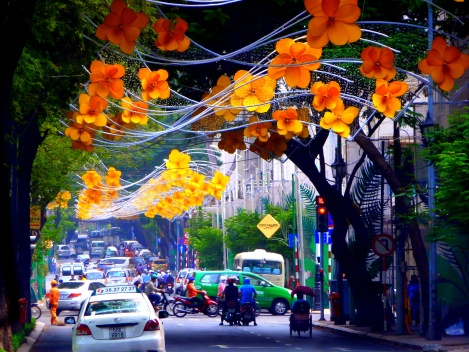
and into My Tho in the Mekong Delta.
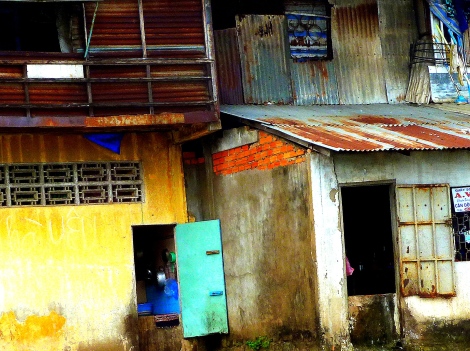
We lunched in private homes with both ARVN vets who fought with the invading American forces and members of the Viet Cong who fought against us. All agreed,
“The war is over. Our job now is to make Viet Nam the best it can be right now–not to waste our time being pre-occupied with the past.”
Guilt laid to rest, there was still worry…
* * * * *
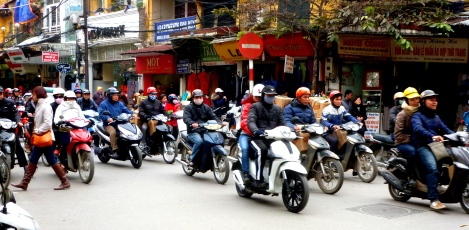
“How does anyone (like the woman at the left of the photo above) get across the street alive,” we asked. “It’s not like Rome where you wait for a nun who’s going your way and tail along behind her.” They said, “Relax. When you want to walk, walk deliberately and steadily across the street. Don’t look left or right. Don’t speed up, slow down or stop. Cross like you’ve got the right to do so. You do! People on bikes, motorbikes, in cars and trucks, they’ll see you and go around you. If they can’t go around you, they’ll stop. No one will honk or yell–the way they say they do in your country.”
* * * * *
After that reality and theory fell into place. Maybe because I want to believe it, I do see the hand of the Buddha in the veterans’ focus on the present and in the mutual respect shown by those who use the street. I see it in the harmony of native and French cuisines, in a guide telling us, “We are a very practical people. We eat everything.” This was our introduction to weasel coffee. (In the words of Yogi Berra, “You could Google it.”)

* * * * *
A remarkable number of my trip photos are of people: workers, kids, some Buddhist nuns. The kids all go to school. Everyone else works. It’s said in Viet Nam, “If you don’t work, you die.” More Buddhism?

There’s more to say about this trip and the 3 day extension into Kampuchea (what the Cambodians call Cambodia) with Angkor Wat and a floating village and memories of the Khmer Rouge and the Killing Fields. Stay tuned.

One of my lasting memories of Viet Nam is of going through the claustrophobic tunnels and ending up in a large room where we were served tea and cookies.
LikeLike
Goldberg, the photos are great. Please tell me what kind of camera you used and also some advice about cameras and brands of cameras in general. I want something not too heavy that takes photos and movies as it’s time to upgrade. I lost your email address so please send that. thanks.
LikeLike
Joanna,
The camera I brought to Viet Nam was a Lumix by Panasonic. While the photo quality, handling, controls are all quite good, the camera is very poorly protected from dirt and moisture on the inside. Look at the attached photo. There are spots throughout the open sky and along the tall tower to the right.
The camera has been replaced by an Olympus SZ 12, a camera now 2 models out-of-date. As yet I’ve not used it enough to comment on it.
In the past I’ve had good results with Canon cameras and, way back when, with a Kodak Bobbie still uses. That Kodak is 4 (!) megapixels and produced the 14×17 Sadhu photo we display on the living room wall. Don’t get caught up in number of megapixels or special features. Most cameras have image stabilization, but you still need a solid stance and hand to use the camera well. My current Olympus has a 24x optical zoom, which asks a lot of my aging muscles.
Whatever, I’m content with point-and-shoot cameras. They’ve fit in my pocket and given me 11×14 and 12×18 enlargements I’ve been quite happy with.
When I think of your past shooting, I remember a great deal of speed and spontaneity. Check the time lapse between depressing the shutter button and the shutter actually firing. Also check how long the camera takes after shooting to be ready to fire again. I generally rely on the automatic setting. You may want a camera that allows easy use of manual settings.
Be well!
RSG
LikeLike
Oh Richard, your pictures are so magnificent. It almost makes me
want to go there. I’ve only been to India and Hong Kong. I figured that
was close enough. Keep them coming.
MS Smith
LikeLike
Richard,
I have wanted to travel to SE Asia for sometime. Your pictures are so evocative…I have left them up on my computer so I can view them from time to time. So colorful! Thanks for sharing your talents,
James
LikeLike